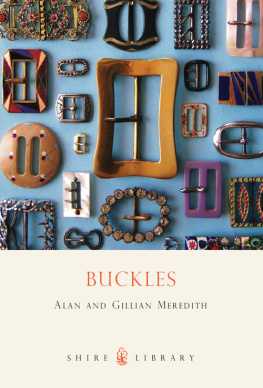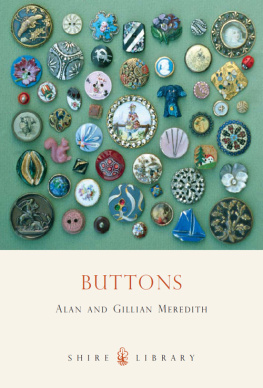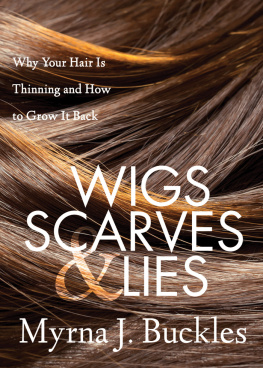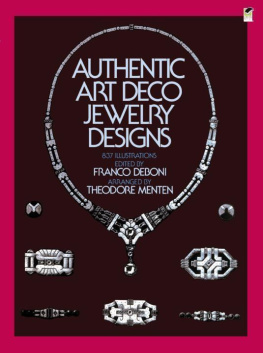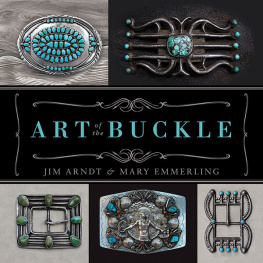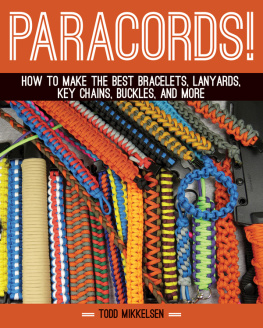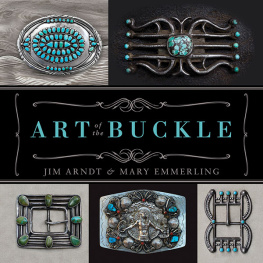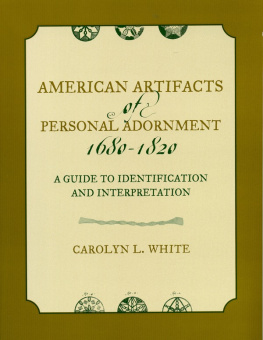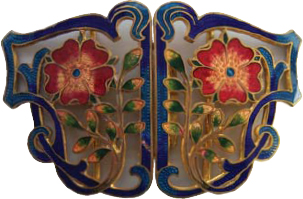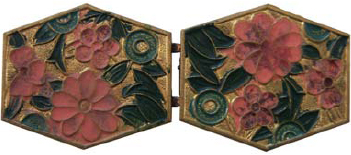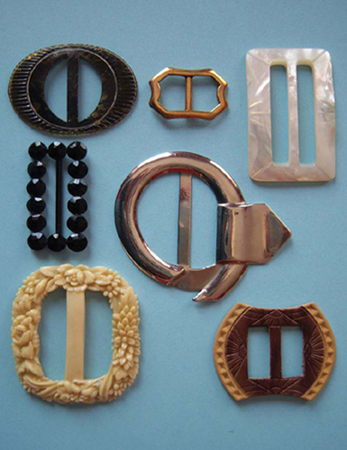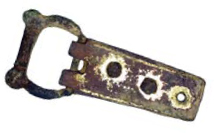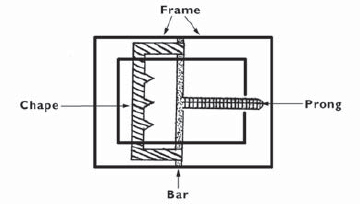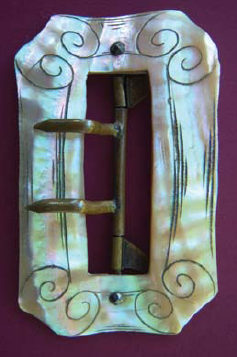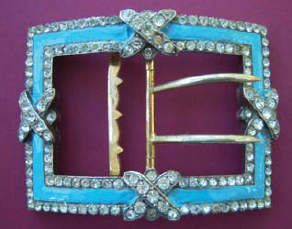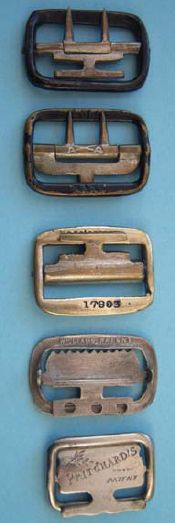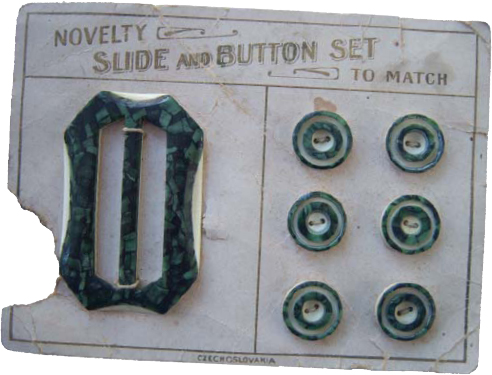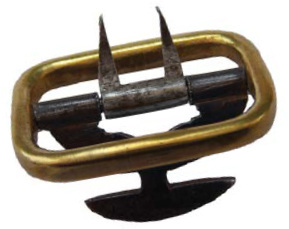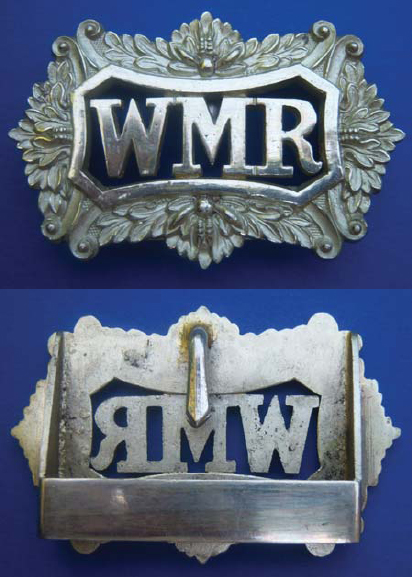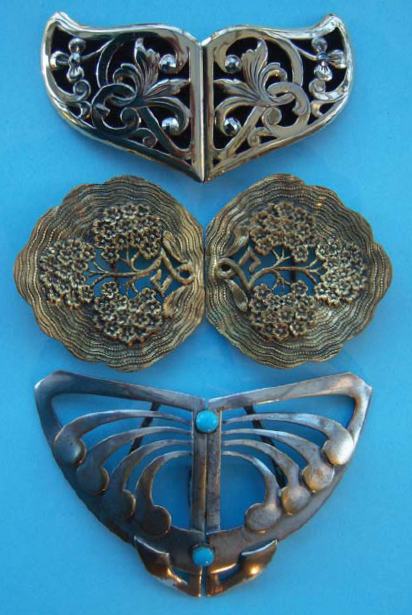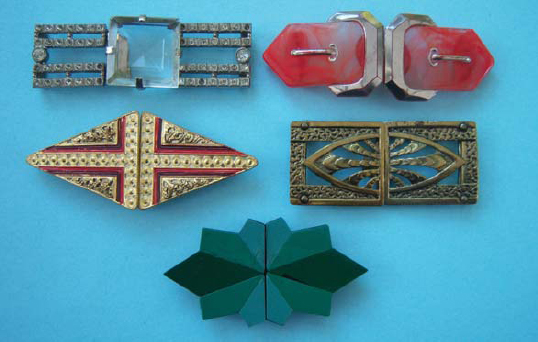BUCKLES
Alan and Gillian Meredith
SHIRE PUBLICATIONS
CONTENTS
INTRODUCTION
Various slides. Left to right. Top Celluloid, c. 1930s. Metal, late twentieth century. Pearl with cut design. Middle Black glass discs glued to shaped frame, late nineteenth century. Chrome deco, c. 1930s. Bottom Moulded plastic, mid-twentieth century. Celluloid, c. 1930s.
B UCKLES have a very long history, being indispensable for joining the two ends of straps in a secure but adjustable manner. The importance of their invention cannot be overemphasised but they are usually overlooked and taken for granted. This book aims to give a brief insight into the development and uses of buckles in all their forms. Buckles issued specifically for the military are excluded as other publications cover this subject.
Buckle frames come in many shapes and sizes depending on the intended use and the prevailing fashion. The frame, being the visible part, carries any decoration. It may be slightly rounded to accommodate the curve of a shoe front. A reverse curve indicates that the buckle was intended for use with thick material, the shape making it easier to thread the strap end over the bar. For use with thick leather, the bar was set away from the frame. If the leather was too thick to bend, a plate would be hinged on to the bar and the leather riveted to the plate.
Metal detector find. Buckle with plate. Medieval period.
Chapes of various designs could be fitted to the bar to enable one strap end to be temporarily secured before fastening the other. This made buckles easily removable and consequently interchangeable. As buckles were expensive, this could be a great advantage. Unfortunately the teeth or spikes on the semi-circular chapes damaged the straps or belts, making frequent repairs necessary. Buckles fitted with T-, anchor- or spade-shaped chapes avoided this but needed a slotted end in the belt to accommodate them.
For the purpose of this book, the indicated terminology has been used. Other publications may differ.
Buckle. Iridescent pearl with cut patterns. Last half of the nineteenth century.
Buckle. Blue enamel edged in diamant, toothed chape. Second half of the nineteenth century.
Utilitarian buckles with various chapes. Top T or anchor shape. Second down Similar with crossed swords; trademark of Wilkinson Sword. Middle Registered number 17803; design registered in 1885. Fourth down Marked Williams Patent. Bottom Marked Pritchards Patent. All from the late nineteenth/early twentieth century.
Buckle. Brass. Bar set back from the frame to take thick material. Steel prong.
Original card, c. 1930s.
A buckle without chape or prongs is called a buckle trim or a slide. It may have been designed in this way, or it could have lost its prong in use. This type was frequently used in home dress-making, the belt end being secured with a hook and eye, as without any prongs there was no need to do the intricate stitching round the eyelet holes. The same style, as its term indicates, was widely used purely for decoration, particularly on shoe fronts, where it could conceal an unattractive elastic fitting.
The conventional buckle with a frame, bar and prong gives the most reliable and easy-to-use closure for a belt but affords little space for decoration. On the other hand, a solid or fretted plate, with a hook or stout, blunt prong and a chape on the back to take the belt ends, gives plenty of scope for decorative designs. However, a hook in this position may be difficult to do up, and wear on the belt from constant use of the prong in one place can stretch the fabric making it insecure. This style was used on civilian uniform buckles in the nineteenth century and for trouser and jeans buckles in the twentieth century.
Buckle. Brass, spade-shaped chape, sharp prongs. Size, 1 inch.
Buckle from West Midland Railway bandolier, with reverse showing fittings.
Although we casually refer to any device joining belt ends as a buckle, if it consists of two separate pieces, one for a hook and one for a loop, it should be called a clasp. Clasps were particularly popular at the turn of the nineteenth century. Their main disadvantage is that as each belt end is securely fixed to each clasp piece, the size of the belt is not easily adjustable without the aid of an inserted elastic panel.
Great ingenuity was shown by manufacturers in the designs of fully and securely interlocking two-piece buckles. One such type was often used for civilian uniforms as it could incorporate a flat front surface large enough to carry the required insignia. A variation of this type incorporated a removable dagger-shaped spoke joining the two buckle pieces.
Clasps. Top Plated metal with rivet decoration, black velvet backing, marked Dpos. Middle Tinted brass. Bottom Electroplated brass, marked Ges Gesch. All from the late nineteenth/early twentieth century with art nouveau influence.
Clasps. Left to right. Top Diamant. Moulded glass with lustre paint.

